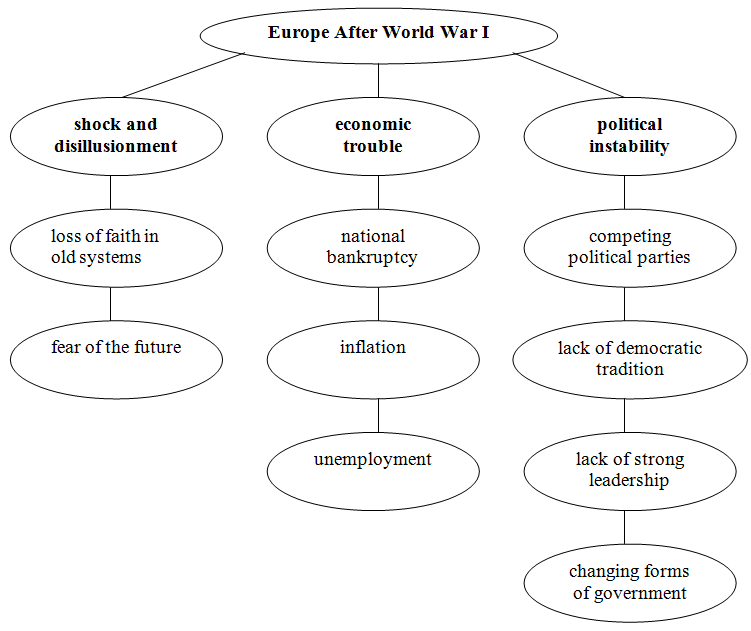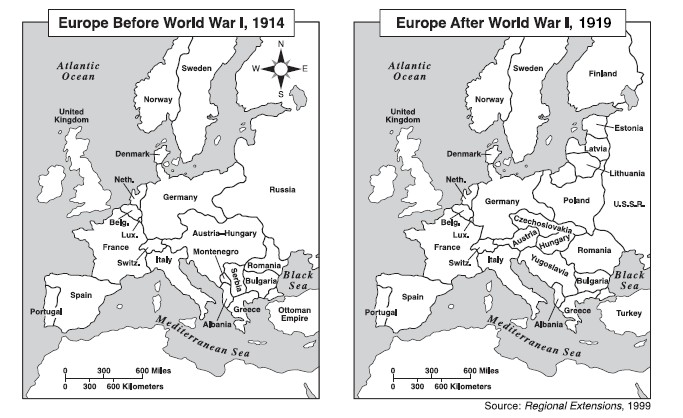World History and Geography: The Modern World
10.6 - Students analyze the effects of the First World War.
Purpose of this site is to provide you information as it relates specifically to the California State Standards
 |
CALIFORNIA CONTENT STANDARD 10.6.1 | The Treaty of Versailles |
|---|
Specific Objective: Analyze the aims and roles of world leaders in negotiating the terms of the Treaty of Versailles; Analyze the influence of Woodrow Wilson’s Fourteen Points; Analyze the causes and effects of U.S. rejection of the League of Nations.
The Fourteen Points
During World War I, U.S. President Woodrow Wilson drew up a proposal for postwar peace that was known as the Fourteen Points. It included:
- general suggestions for encouraging peace, such as an end to secret treaties
- specific recommendations for changing borders and creating new nations, based on the principle of national self-determination—allowing people to decide for themselves under what government they wished to live
- a call for “a general association of nations” that would peacefully negotiate solutions
to world conflicts, Wilson’s Fourteenth Point, which led to the creation of the League of Nations
Negotiating the Treaty of Versailles
The Fourteen Points were the basis for talks that led to the 1919 Treaty of Versailles.
- The talks were attended by delegates from Allied and neutral nations.
- Germany and its allies were not allowed to participate.
- Most negotiations were made by the so-called Big Four: George Clemenceau, premier of France—wanted Germany to be punished; Vittorio Emanuele Orlando, premier of Italy—sought territory for Italy; David Lloyd George, prime minister of Great Britain—worked for compromise; Woodrow Wilson, U.S. president—had to abandon many of his Fourteen Points.
Terms of the Treaty
- The League of Nations, an international peace organization, is established; Germany and Russia are excluded from membership.
- Germany returns the provinces of Alsace and Lorraine to France, gives up its overseas colonies, reduces its army in size, is forbidden to buy or make weapons, and to have submarines or an air force, is assigned sole responsibility for the war, and must pay the Allies $33 billion in wartime reparations.
The United States Rejects the League of Nations
In November 1919, the U.S. Senate rejected the Treaty of Versailles. The League of Nations was the main sticking point. Some Americans were concerned that membership in the League would diminish the right of the United States to make its own decisions. More importantly, the treaty required each member nation to support the boundaries of other member nations—a requirement that many feared could lead to U.S. involvement in future European wars.
Directions: Choose the letter of the best answer.
1.U.S. president Woodrow Wilson’s Fourteen Points were
- the basis for determining German reparations.
- a charter for the League of Nations.
- an outcome of the Treaty of Versailles.
- a plan for postwar peace.
2.Which statement best summarizes the idea of national self-determination as it was presented in Woodrow Wilson’s Fourteen Points?
- Strong national boundaries strengthen national unity.
- Voter participation in a democracy is the best way to encourage peace.
- All people have the right to independence from colonial rule.
- People should be able to decide on their type of government.
3.The Big Four who negotiated the Treaty of Versailles represented France, Great Britain, the United States, and what other nation?
- Germany
- Italy
- Russia
- Spain
4. Which of the following did the Treaty of Versailles require of Germany?
- payment of damages to its overseas colonies
- a public apology to the Allies
- acceptance of sole responsibility for the war
- division into two states: West Germany and East Germany
5.The main purpose of the League of Nations was to
- keep the peace and prevent future wars.
- regulate commercial and economic competition.
- impose sanctions on aggressive nations.
- achieve international cooperation in governing colonies.
6. What is the main reason that Americans rejected the League of Nations?
- They objected to Germany’s membership.
- They believed the financial aid it provided would burden the U.S. economy.
- They feared it could lead to future U.S. involvement in European wars.
- They did not want to help rebuild postwar Europe.
 |
CALIFORNIA CONTENT STANDARD 10.6.2 | Europe After World War I> |
|---|
Specific Objective: Describe the effects of World War I and resulting terms of peace on population shifts, world economy, and political borders in Europe and the Middle East.
Read the maps and the summary
The Treaty of Versailles was only one of a number of treaties negotiated at the end of World War I. The treaties resulted in new national boundaries and new countries.
As the maps show, the postwar treaties carved up old empires into many small new nations, causing huge land losses for the Central Powers and changing the face of Europe.
- The former empire of Austria-Hungary was dissolved, and new nations were created from its land: Austria, Hungary, Czechoslovakia, and Yugoslavia.
- The Ottoman Turks had to give up much of their land in southwest Asia and the Middle East. In Europe, they retained only the country of Turkey.
- Poland, which had long been divided among Germany, Russia, and Austria-Hungary, was reconstituted.
- Russian land yielded the new nations of Finland, Estonia, Latvia, and Lithuania.
- Russia and Austria-Hungary gave up additional territory to Poland and Romania.
Directions: Choose the letter of the best answer.
1.Who lost the greatest percentage of land in the creation of new nations?
- Austria-Hungary
- France
- Germany
- Russia
2.Which nation was formed from the former lands of the Ottoman Empire?
- Albania
- Finland
- Hungary
- Turkey
3. Which formerly dissolved nation was reconstituted on the Eastern Front?
- Bulgaria
- Czechoslovakia
- Poland
- Romania
4 . In what region of Europe were the new nations of Finland, Estonia, Latvia, and Lithuania created?
- northeast
- northwest
- southeast
- southwest
5. After World War I, Serbia became part of
- Hungary.
- Romania.
- Russia.
- Yugoslavia.
6.After national boundaries were redrawn, which of the Central Powers lost access to the sea?
- Austria-Hungary
- Germany
- The Ottoman Empire
- Russia
 |
CALIFORNIA CONTENT STANDARD 10.6.3 | Postwar Disillusionment in Europe |
|---|
Specific Objective: Understand the widespread disillusionment with prewar institutions, authorities, and values that resulted in a void that was later filled by totalitarians.
Read the summary and cluster diagram
World War I shook the economic and political foundations of Europe. The war left nearly every major nation bankrupt and, after centuries of rule by kings, brought an end to the continent’s last great empires.
The diagram shows some of the troubles facing postwar Europe. In several countries, these troubles paved the way for the rise of totalitarian government—a government which takes total control over nearly every aspect of people’s lives.

Directions: Choose the letter of the best answer.
1.Which statement best describes national economies in Europe after World War I?
- In most areas, wartime industry brought significant economic gains.
- Western Europe remained economically strong, but the economies of eastern and southern Europe were devastated.
- Almost all the major economies were bankrupt.
- Although the war battered most European economies, with the help of wartime reparations paid by Germany, they soon rebounded.
2. By the end of World War I, what political tradition had essentially ended in Europe?
- rule by the old empires
- totalitarian government
- the democratic tradition
- competition among political parties
3. Which generalization is true of political life in postwar Europe?
- People clung to old forms of government.
- Strong leadership made the public anxious.
- Many countries had no organized political parties.
- Changing forms of government created a sense of insecurity.
Use the quotation to answer questions 4 and 5.
“It is the State which educates its citizens in civic virtue, gives them a consciousness of their mission, and welds them into unity.” —Benito Mussolini, from The Social and Political Doctrines of Contemporary Europe, edited by Michael Oakeshott
4. In the quotation, what post-World War I problem is Italian dictator Benito Mussolini most likely addressing?
- economic change
- a sense of loss
- weak political systems
- unemployment
5 .In the quotation, what is most central to Mussolini’s solution to political turmoil?
- state-run education
- individual opinions
- shared wealth
- a leader’s moral choices
 |
CALIFORNIA CONTENT STANDARD 10.6.4 | Artists in the West After World War I |
|---|
Specific Objective: Discuss the influence of World War I on literature, art, and intellectual life in the West (e.g., Pablo Picasso, the “lost generation” of writers).
Read the summary and the chart
The years after World War I brought an outpouring of creative work. Many artists and thinkers felt cynical about the past, and sought new means of expressing themselves. Some composers experimented with harsh combinations of sounds; some painters explored the idea that things are not what they seem. Many of these means of expression had emerged around the turn of the century, but the war accelerated their development.
The term “lost generation” describes a group of American writers in Paris after the war, including Ernest Hemingway, F. Scott Fitzgerald, and Gertrude Stein. Their writing sometimes conveyed a sense of loss and meaninglessness. The term “lost generation” is also used in a general way to describe those who grew up during the war, saw the old ideals fail, and had to work to find new meaning in an unstable world.
| Art | |
| Rebelled against ... |
|
| Explored ... |
|
| Famous Figures |
|
| Architecture | |
| Rebelled against ... |
|
| Explored ... |
|
| Famous Figures |
|
| Literature | |
| Rebelled against ... |
|
| Explored ... |
|
| Famous Figures |
|
| Music | |
| Rebelled against ... |
|
| Explored ... |
|
| Famous Figures |
|
Directions: Choose the letter of the best answer.
Use the quotation to answer questions 1 and 2.
In the post-World War I novel, All Quiet on the Western Front, a young soldier named Paul says of the older generation:
“The idea of authority, which they represented, was associated in our minds with a greater insight and a more humane wisdom. But the first death we saw shattered this belief.”
—from All Quiet on the Western Front, Erich Maria Remarque
1. What common post-World War I literary theme is characterized by Paul in the quotation from All Quiet on the Western Front?
- Poor military leadership had created a war that could not be won.
- Young soldiers were lured to die in battle under false pretenses.
- The horrors of war destroyed the young soldiers’ trust in their elders.
- Life on the battlefield meant that soldiers rarely saw their leaders.
2. Which emotion best describes both Paul’s words in the quotation, and “lost generation” literature in general?
- patriotism
- terror
- relief
- disillusionment
3. After World War I, many artists, architects, writers, and musicians rejected
- government funding.
- traditional styles.
- cultural change.
- their own feelings.
4. What project would likely be chosen by a European architect, such as Le Corbusier or Gropius, after World War I?
- a luxury apartment building decorated with carved limestone
- a splendid monument honoring the new state leadership
- a space-efficient dormitory built of steel and glass
- the restoration of a palace that was damaged in the war
5.The “lost generation” of writers who gathered in Paris were considered “lost” because
- the war had left them with a sense of meaninglessness.
- they wrote about soldiers who were unable to return home.
- their homes were destroyed in the war.
- shifting boundaries meant they no longer lived in their nations of origin.
